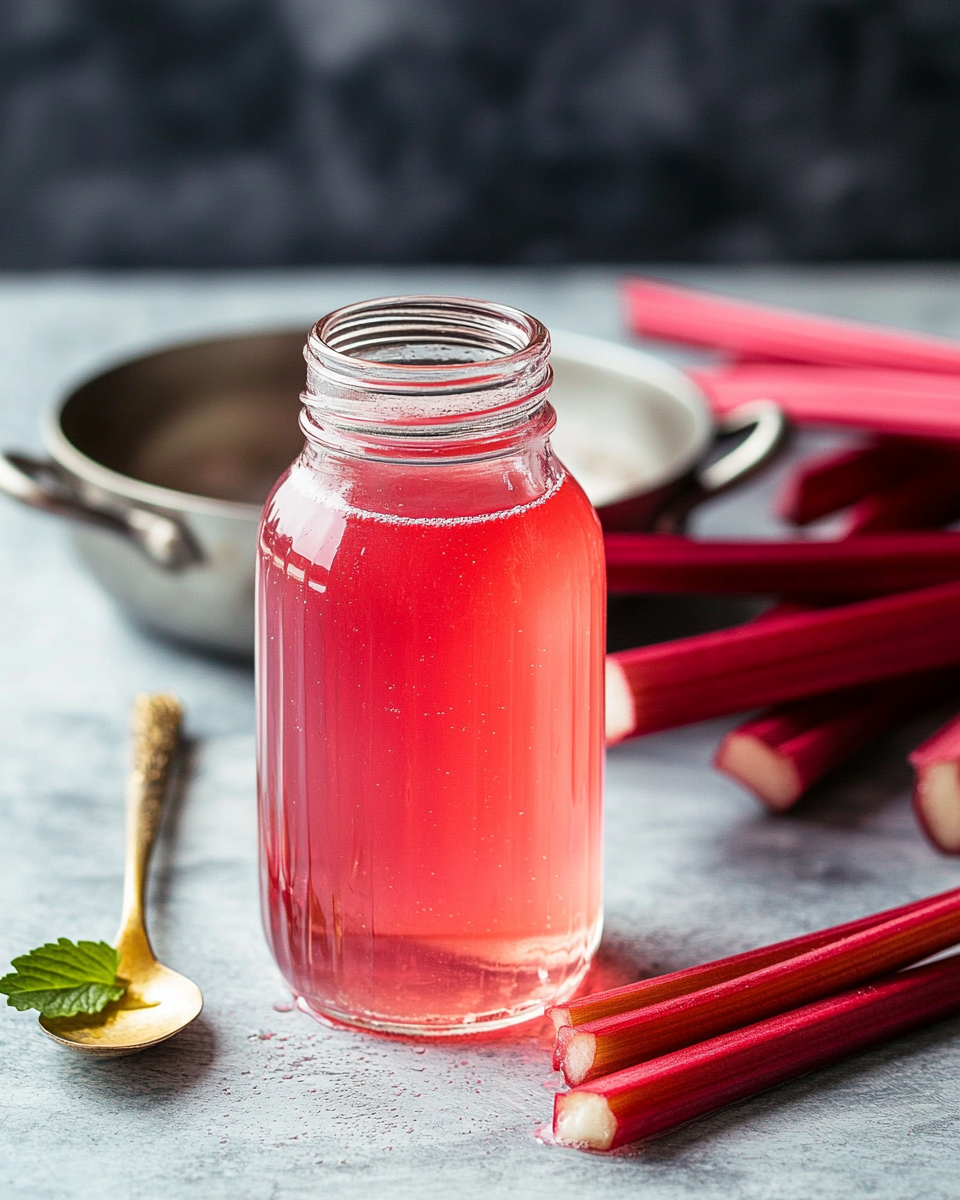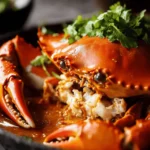This homemade rhubarb simple syrup is a vibrant and tangy sweetener perfect for enhancing drinks, desserts, or cocktails. Made from fresh rhubarb, sugar, and water, it brings a bright pink color and unique tart flavor to any recipe.
FULL RECIPE
Ingredients
- 2 cups chopped fresh rhubarb
- 1 cup granulated sugar
- 1 cup water
Directions
- Combine rhubarb, sugar, and water in a medium saucepan.
- Bring the mixture to a boil over medium heat, stirring occasionally until the sugar dissolves.
- Reduce heat and simmer for about 10 minutes, allowing the rhubarb to break down and infuse the syrup.
- Remove from heat and let cool slightly.
- Strain the syrup through a fine mesh sieve into a clean container, pressing gently to extract liquid.
- Discard solids and refrigerate the syrup until chilled.
- Use within 2 weeks for best flavor.
Nutritional Information
- Calories: 60
- Total Fat: 0g
- Sodium: 0mg
- Total Carbohydrates: 16g
- Sugars: 16g
- Protein: 0g
History and Origin of Rhubarb Syrup
Rhubarb syrup has roots that trace back to traditional uses of rhubarb in various cultures, especially in Europe and Asia. Rhubarb itself was initially valued for its medicinal properties before becoming a popular culinary ingredient. The transformation of rhubarb into syrup showcases the adaptability of this tart vegetable into a sweet, versatile product that has been cherished for generations.
Nutritional Benefits of Rhubarb
Rhubarb is rich in vitamins such as vitamin K and C, along with minerals like calcium and potassium. While the syrup version contains added sugar, it still retains some antioxidants and nutrients from the rhubarb. This makes rhubarb syrup a flavorful way to enjoy some of rhubarb’s health benefits, especially when used in moderation.
Flavor Profile
Rhubarb simple syrup offers a unique balance of tartness and sweetness. The natural acidity of rhubarb gives it a refreshing tang, which is mellowed by the added sugar. This distinctive flavor makes it a fantastic complement to both sweet and savory dishes.
Uses in Cocktails and Beverages
One of the most popular applications of rhubarb syrup is in cocktails. It adds a vibrant color and a crisp, tangy taste that pairs well with spirits like gin, vodka, and whiskey. Beyond alcoholic drinks, it can enhance iced teas, lemonades, and sparkling water, providing a natural fruit sweetness and a splash of color.
Pairing Rhubarb Syrup with Foods
Rhubarb syrup is excellent drizzled over desserts like cheesecake, ice cream, and panna cotta. It also works well as a glaze for roasted meats, especially pork and chicken, where its tartness balances the richness of the protein. Additionally, it can be incorporated into salad dressings or sauces for an extra burst of flavor.
Seasonality and Availability of Rhubarb
Rhubarb is typically in season during spring and early summer, making this syrup a seasonal treat for many. Using fresh rhubarb at its peak ensures the syrup has the best flavor and vibrant color. In off-seasons, frozen rhubarb can be an alternative, though the taste and texture may vary slightly.
Making Syrup from Scratch vs. Store-Bought Options
Homemade rhubarb syrup allows for control over sweetness and ingredient quality, ensuring no preservatives or artificial flavors. Store-bought syrups often contain additives or corn syrup, which can affect taste and nutritional value. Making syrup at home also allows customization with added spices or herbs.
Storage Tips for Rhubarb Syrup
Proper storage is essential to maintain flavor and freshness. Refrigeration in a sealed container extends its shelf life up to two weeks. For longer storage, freezing the syrup in ice cube trays is a convenient option. Thawed syrup may separate slightly but can be stirred back to consistency.
Variations on the Basic Rhubarb Syrup Recipe
Many variations exist, such as adding ginger, vanilla, or citrus zest during cooking to enhance complexity. Some recipes incorporate honey or maple syrup instead of sugar for a different sweetness profile. Experimenting with these variations can yield a syrup tailored to personal tastes.
Cultural Significance and Traditions
In some cultures, rhubarb syrup is used not only as a culinary ingredient but also in traditional remedies and celebrations. Its vibrant color and tart flavor symbolize freshness and renewal, often appearing in spring festivals or family gatherings.
Health Considerations When Using Syrup
While rhubarb itself has health benefits, the sugar content in syrup means it should be consumed in moderation. Those monitoring blood sugar or calories should be mindful of portion sizes. Additionally, the leaves of rhubarb are toxic and should never be used in syrup preparation.
Impact on Baking and Cooking
Rhubarb syrup can be a creative substitute for other sweeteners in baking, adding moisture and a subtle tart flavor. It can be brushed on cakes, mixed into batters, or swirled into frostings to add depth and color.
Environmental and Sustainability Aspects
Growing rhubarb is generally low-impact and sustainable. It requires minimal pesticides and grows well in cooler climates. Using homegrown rhubarb for syrup can reduce carbon footprint by cutting down transportation and packaging waste compared to store-bought options.
Rhubarb Syrup in Modern Culinary Trends
With the rise of craft cocktails and artisanal foods, rhubarb syrup has experienced renewed popularity. Chefs and mixologists embrace its natural color and bold flavor as they seek to create visually appealing and uniquely flavored dishes and drinks.
How to Incorporate Rhubarb Syrup into Daily Meals
Beyond special occasions, rhubarb syrup can brighten everyday meals. Add a splash to morning yogurt, oatmeal, or smoothies for a refreshing twist. It also works well in savory marinades or vinaigrettes for lunch and dinner.
Differences Between Rhubarb Syrup and Other Fruit Syrups
Compared to syrups made from berries or citrus, rhubarb syrup has a distinctively tart edge with less overt sweetness. This makes it a versatile ingredient that can balance richer flavors, unlike some fruit syrups that tend to be predominantly sweet.
Common Mistakes to Avoid When Making Rhubarb Syrup
Overcooking can cause bitterness, and insufficient straining may leave unwanted pulp in the syrup. Using too much sugar can overpower the natural rhubarb flavor, while too little will make the syrup too tart. Achieving the right balance is key.
Creative Serving Ideas
Try mixing rhubarb syrup with sparkling wine for a festive spritzer or drizzle over fresh fruit for an elegant dessert. It can also be used to flavor homemade ice pops or as a topping for pancakes and waffles.
The Role of Rhubarb Syrup in Preserving Flavor
Making syrup is a method to capture the rhubarb flavor beyond its short growing season. The syrup preserves the fresh, tangy taste of rhubarb in a concentrated form that can be used year-round.
Advertisement
Allergen Information and Dietary Considerations
Rhubarb syrup is naturally gluten-free, dairy-free, and vegan, making it suitable for many dietary restrictions. However, anyone with a sensitivity to oxalates found in rhubarb should consult their healthcare provider.
Conclusion
Rhubarb simple syrup is a delightful, versatile ingredient that brings a bright, tangy flavor to many dishes and drinks. Its rich history and nutritional benefits, combined with ease of preparation and use, make it a fantastic addition to any kitchen. Whether used in cocktails, desserts, or everyday meals, this syrup offers a refreshing alternative to ordinary sweeteners. By experimenting with variations and creative pairings, you can enjoy the unique taste of rhubarb year-round, enhancing both classic and modern recipes.






